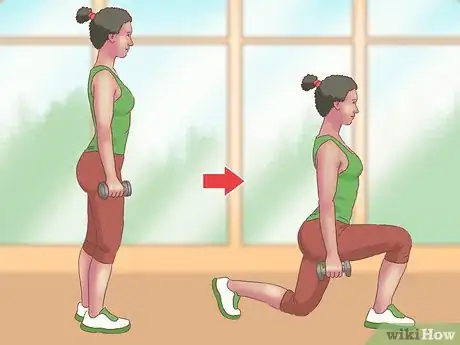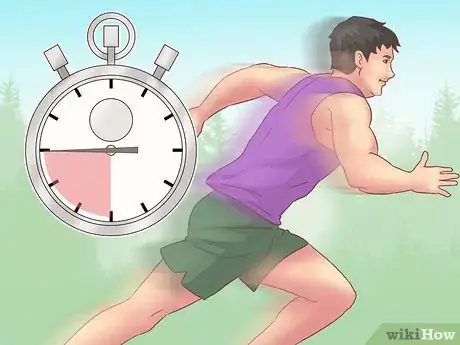This article was co-authored by Melody Sayers, MS, RD, NASM-CPT. Melody Sayers is a Registered Dietitian and NASM (National Academy of Sports Medicine) Certified Personal Trainer. She is the owner of Elevate Your Plate®, a private nutrition counseling and personal training practice, focused on an evidence-based, individualized, realistic, and results-driven approach to improving one's health. With over 8 years of experience, Melody has worked in both the private and public health sectors, helping both individuals and communities achieve milestones in managing their weight and preventing disease. She currently holds a Certificate in Adult Weight Management and a Master of Science in Nutrition, Dietetics, and Food Science from the California State University - Northridge.
There are 7 references cited in this article, which can be found at the bottom of the page.
This article has been viewed 75,412 times.
Since a 5K race is just over 3 miles (4.8 km), you'll need to run your best to improve your 5K race time. To start, practice regularly. Use a combination of long runs and interval training to improve your endurance. Work on amping up your workout by incorporating things like hill training and increasing the duration of your regular workout routine. Make sure you talk to a doctor before starting any new training program. You want to make sure you avoid injury when trying to improve your 5k speeds.
Steps
Amping Up Your Routine
-
1Engage in hill training. Hill training is a form of training where you run up and down hills. This can help build endurance and muscle, resulting in faster speeds. Also, you may encounter a hill during a 5k, so hill training can help you prepare.[1]
- Find a steep hill in a safe area near you. Make sure it's at least 80 to 100 meters long. Start at the bottom of the hill and run up it at a consistent and fast pace. Then, slowly jog back down.
- Start slow. Do hill training once a week, engaging in 4 to 5 repetitions. Gradually work your way up to 8 to 10 repetitions. Do what feels right for your body. When 4 to 5 repetitions begins to feel easy, add one or two more.
-
2Perform workouts that build your leg muscles. Strong legs are essential for a fast pace. Squats and lunges should be a part of your regular workout routine.[2] Start slow with weight training. Only engage in weight training twice a week, doing a small number of repetitions. Never weight train two days in a row.[3]
- To do a squat, stand with your feet hip-length apart and your arms at your side. Lower your body as far as you can by pushing your hips down and bending your knees. Make sure that your toes are not pointed out, your knees do not come over the front toes, and your lower back is not arched.[4] Raise your arms for balance. Pause for a moment and then lift your body back up.[5]
- To do a lunge, stand with your upper body straight and your shoulders held back. Step forward with one leg and bend your knee and lower your hips. Keep lowering until both knees are bent at a 90-degree angle. Then, keeping your weight in your heels, push yourself back to the starting position.
Advertisement -
3Increase the duration and amount of regular exercise. You can increase endurance and strength by adding a bit more to your regular fitness routine. If you usually ride a stationary bike for 45 minutes a day, add an extra 10 minutes to go a full hour. If you usually do 5 to 10 repetitions of sit-ups or push-ups, add an extra 10 to 20 repetitions.[6]
-
4Visualize success. You need to build your mental toughness in addition to your physical toughness to increase your 5k speed. Running fast requires a lot of endurance and dedication. Use visualization to imagine success. Before a run, spend some time imagining yourself successfully finishing the run at a faster speed than normal.[7]
- Take some time just before you start to run. After putting on your running gear, take a seat for a moment. Close your eyes and imagine.
- Make sure to use all your senses. Think about the smells and sounds you'll hear outside. Imagine how your body feels during a run. Think about the sensation of sweat and the dry taste in your mouth. Think about the smells of cement or the nearby woods you run past.
- Imagine finishing the run in record time. Imagine pushing yourself without faltering or growing tired. Then, once you've finished visualizing, exit and take on your run.
Practicing Regularly
-
1Incorporate a single longer run each week. Building endurance can help you run faster. This will increase your aerobic capacity, giving you an extra push to run faster during a 5k.
- Strive for one 30 to 45 minute run each week. Make time for a run of this length in your schedule.
- You do not need to push yourself to run at extraordinary speeds during your longer run. Strive for a steady, sustainable pace. The point here is to build up endurance.
-
2Interval train once a week. Interval training is training where you alternate between a steady pace and bursts of intense speed. Interval training, much like longer runs, can help you build the endurance necessary to sustain a faster pace during a 5k.[8]
- To start, spend 5 to 10 minutes warming up with a brisk walk or a slow jog.
- When you start running, go at your regular pace for a certain distance or time period. There are no set rules for interval training. You can try running at a regular pace for 400 meters, and then speeding up for 100 meters. You could also try jogging at a steady pace for 4 minutes, and then pushing yourself as hard as you can for one minute.
- Continue switching between steady paces and quick paces for the normal length or time of your run.
-
3Run outside regularly. Running on a treadmill works in a pinch if weather is bad. However, you should mostly stick to running outside when trying to boost your speed in a 5k. A 5k will be held outdoors. Your body should be used to the atmosphere of the outside to adequately prepare. Avoid the treadmill unless the weather is too harsh for an outdoor run.[9]
- Make sure you choose a safe area to run.
- If you're running after sunset, make sure to wear bright colors so you're easily spotted by drivers.
-
4Have one easy running day to recover. If you're doing a long or fast run multiple days per week, your body needs time to recover. You need at least one slow run day per week, where you do a slow jog or a brisk walk in lieu of a long, intense run. If you push yourself too much for too long, you'll end up straining your body and crashing.[10]
Taking Precautions to Avoid Injury
-
1Talk to a doctor or trainer before starting a new fitness plan. You should never engage in a new fitness plan without talking to a doctor or trainer first. You want to make sure your body is ready for the added strain of extra, harder workouts. A qualified doctor or licensed trainer can help you come up with a training plan that works for your specific needs.
-
2Warm up prior to workouts. You should always warm up before a run. This can help prevent muscle strain, soreness, and injury. Take 5 or 10 minutes to engage in a solid warm up before you jump into your regular run.[11]
- To start, walk for two to five minutes. Then do a slow run for about half a mile, taking frequent walking breaks.
- When you begin running, go slowly for the first 10 steps to help your body warm up. Then, increase to your regular pace.
-
3Cool down after workouts. Never stop abruptly after finishing a run. You should always transition from running to light jogging and then to walking. For 10 minutes after your run, jog slowly with walk breaks. Then, walk for about three to five minutes to allow your body to cool down.[12]
Expert Q&A
-
QuestionHow can I improve my running skills?
 Tyler CourvilleTyler Courville is a brand ambassador for Salomon Running. He has run in 10 ultra and mountain races across the United States and Nepal, and won the 2018 Crystal Mountain Marathon.
Tyler CourvilleTyler Courville is a brand ambassador for Salomon Running. He has run in 10 ultra and mountain races across the United States and Nepal, and won the 2018 Crystal Mountain Marathon.
Professional Runner I think the truth is that you just have to run a lot to get good at running. I think there are people with raw talent, who will be good racers, but it doesn’t really feel good for anyone when you’re starting out; in fact, it feels pretty miserable. I think what it comes down to is finding ways to make it fun.
I think the truth is that you just have to run a lot to get good at running. I think there are people with raw talent, who will be good racers, but it doesn’t really feel good for anyone when you’re starting out; in fact, it feels pretty miserable. I think what it comes down to is finding ways to make it fun.
References
- ↑ http://www.oksportsandfitness.com/NeedForSpeed.php
- ↑ Melody Sayers, MS, RD, NASM-CPT. Registered Dietician & Personal Trainer. Expert Interview. 6 May 2020.
- ↑ http://www.menshealth.co.uk/fitness/win-the-mind-game/5-simple-ways-to-improve-your-5k-time
- ↑ Melody Sayers, MS, RD, NASM-CPT. Registered Dietician & Personal Trainer. Expert Interview. 6 May 2020.
- ↑ http://30dayfitnesschallenges.com/how-to-do-a-squat/
- ↑ http://www.menshealth.co.uk/fitness/win-the-mind-game/5-simple-ways-to-improve-your-5k-time
- ↑ http://www.telegraph.co.uk/men/active/10568898/Sports-visualisation-how-to-imagine-your-way-to-success.html
- ↑ http://www.oksportsandfitness.com/NeedForSpeed.php
- ↑ https://www.jennyhadfield.com/improve-runnng-speed/
















-Step-17-Version-2.webp)




















































